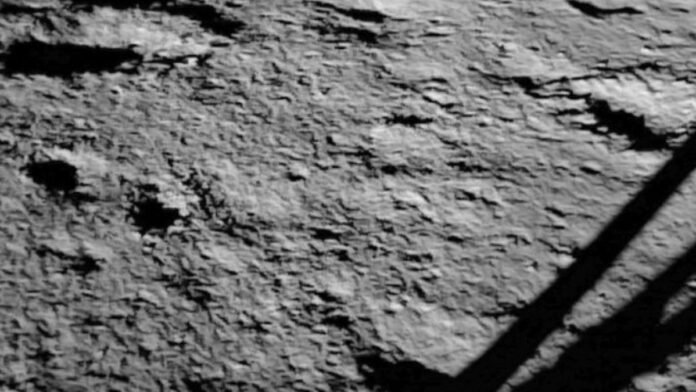The Chandrayaan-3 mission’s lander, Vikram, landed on a flat lunar surface, according to images taken by the Landing Imager Camera. The space agency confirmed the landing location and established a communication link between the lander and the Mission Operations Complex (MOX) of the space agency.
Photos taken by the camera aboard the Chandrayaan-3 mission’s lander “Vikram” indicated that it picked a reasonably flat area of the lunar surface to land in.
On Wednesday, SRO tweeted a picture of Chandrayaan-3’s landing location that was taken by the Landing Imager Camera following the touchdown. A leg and its shadow are also visible.
These photos taken by the touchdown Imager Camera after the touchdown revealed a section of Chandrayaan-3’s landing location shortly after Vikram, with its four landing legs, had safely touched the Moon. A leg and its associated shadow are also seen, according to ISRO.
The space agency stated that Chandrayaan-3 “selected a relatively flat region on the lunar surface.”
Additionally, it stated that a communication link had been established between the lander and the Mission Operations Complex (MOX) of the space agency nearby. The ISRO Telemetry, Tracking and Command Network (ISTRAC) is where the MOX is situated.
Additionally, ISRO made photographs available that were captured by the Lander Horizontal Velocity Camera during the fall to the Moon’s surface.
The lander module for the Chandrayaan-3 expedition touched down on the Moon’s surface on Wednesday.
The lander and rover are intended to function for one lunar day (about 14 days on Earth).
To guarantee a secure touchdown, the lander is equipped with a number of sensors, including an accelerometer, altimeters, Doppler velocimeter, inclinometer, touchdown sensor, and a variety of cameras for obstacle avoidance and location awareness.
The rover is housed in a chamber aboard the lander that has a ramp for deploying it onto the Moon’s surface.
Conclusion:-
The Chandrayaan-3 mission’s lander, Vikram, was found to have chosen a level area on the lunar surface to land. The space agency confirmed that the lander had a communication link with the Mission Operations Complex (MOX) of the space agency, located near the ISRO Telemetry, Tracking and Command Network (ISTRAC). The lander module, equipped with sensors for obstacle avoidance and location awareness, touched down on the Moon’s surface on Wednesday. The rover is housed in a chamber with a ramp for deploying it onto the Moon’s surface.



